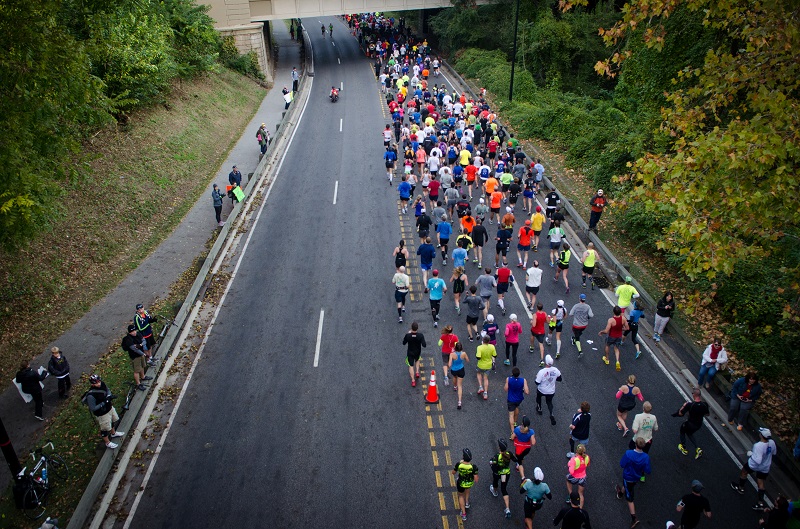
This article originally appeared in the January/February 2014 issue of RunWashington.
Runners run, elected officials legislate and besides the dozens of honorary congressional chairs for the Cherry Blossom Ten Mile, never the twain shall meet.
Until October 2013. The first federal government shutdown in 17 years threw the running community into uncertainty as runners were ostensibly banned from National Park Service property and race permits for that land disintegrated, putting the region’s marquee race in doubt.
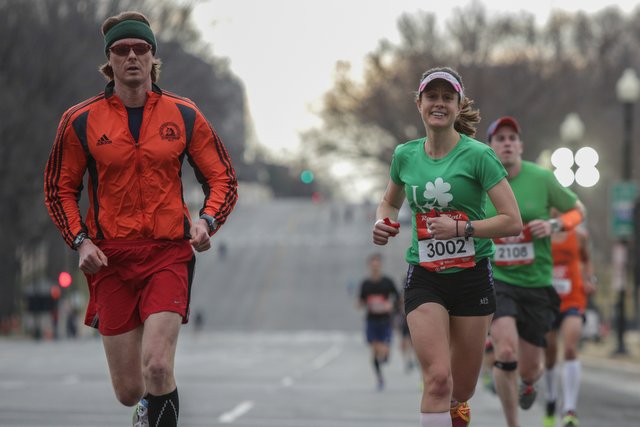
Boston, New York, Marine Corps, Chicago. Getting into one of these marathons is half the battle. Year after year, missed qualifying times and bad luck with lotteries are the source of much heartache for runners. To some, racing on behalf of a charity offers a back door to the starting line when all else fails.
But these charity runners will tell you it’s not about the race bib.
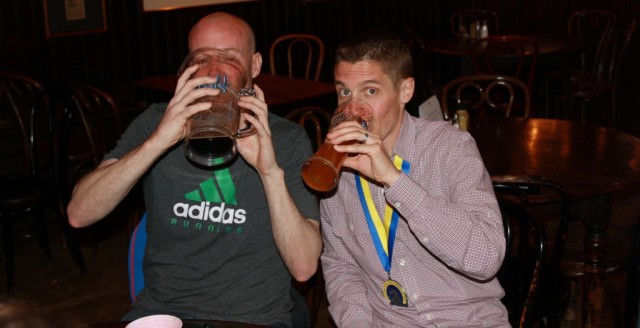
Show us your Runspringa
The mylar blanket, the medal, even the shoes, they all come off. The painful shower, alerting you to chafing that went unnoticed in the heat of the race, washes away the last of the sweat that went into this whole enterprise.
It’s time for a break, either by choice — and in the name of good sense — or by necessity, because the thought of running again right now seems almost barbaric. If you don’t think so, just try walking down a flight of stairs.
Maybe it was a PR, a BQ or a OTQ. Maybe it was a disaster. Either way, it’s over and life is back to normal.
What will that life be?
The Amish have a tradition — Rumspringa — in which their teenagers live in the secular world to decide what life they want to lead, if they want to come back. Marathon runners do the same thing. They toss their training logs aside, stay out late, eschew the (sometimes) monastic life they’d built for themselves. And they figure out if it is really for them. It’s Runspringa.
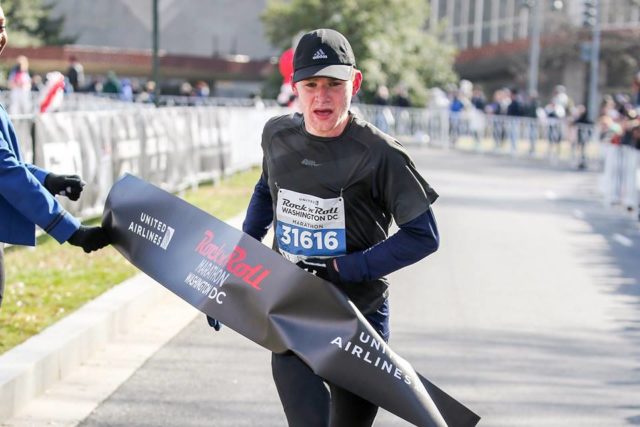
For a year and a half, Sam Doud didn’t race.
After he walked away from collegiate running at American University, he just logged his miles, enjoyed the sport and bided his time until he was ready to race truly long distances.
“I’ve never been one of the fast guys, I never broke 4:20 for the mile,” he said. “A marathon seemed pretty natural for me.”
In February, he started getting itch to see what he could do — he was running fast and ready for the challenge. The Rock ‘n’ Roll D.C. Marathon started a few miles away from his Glover Park home, what better place to see what he could do? Ended up being a good move.
In winning the race Saturday morning, he blazed the fastest time (2:26:57) since the course was beefed up two years prior, and left two solid marathoners in his wake in 2013 Marine Corps Marathon Champion Girma Bedada and six-time Rock ‘n’ Roll/National Marathon winner Michael Wardian.
Doud, 21, showed up with his roommate and put on his bib — number 31616 — and saw Wardian (bib number 1) and Bedada (bib number 2) near the starting line.
“I has no idea who they were, but they looked fast and people were taking a lot of pictures with Wardian,” Doud said. “My main plan was to not blow up, so I wasn’t going to go with them. I’d let them do their things.”
But he ended up catching them both, running with Wardian between miles 11 and 17, then reeling in Bedada with a mile and a half to go before putting three minutes on him.
Though the back half of the race is always lonely, marathoners usually have the half runners to keep them company through 12 miles. This year the marathoners started an hour and a half before the half. With Metro’s Safetrack restrictions keeping race organizers from opening the system early, they started marathoners early and allowed the more than 13,000 half runners take the trains into the city. The marathon’s 2,373 finishers were on their own to get to the start. That meant empty streets for Doud and his competitors, with few spectators braving the cold, though he got a boost from passing the statue of Simón Bolívar near the first mile mark.
When Doud crammed for the race with a few marathon-pace workouts, he targeted 5:50 miles. On race day, he averaged 5:36 per mile, and only his cautious first mile was slower than his initial goal pace.
“This has me wondering what I could do if I seriously train for a marathon,” he said a day after the race.
Despite his early success, he has a lot to learn. For instance, Wardian remarked to him after the race that he hadn’t seen Doud eat anything during the race.
“I told him I didn’t see any food,” he said, at the time unaware of the bevy of running gels and calorie-replacement options available to runners, including at one water stop.
Still, he never hit the wall, and felt comfortable throughout the race, even in the latter stages. He remarked that the climbs around Fort Dupont Park were far more difficult than out of Rock Creek Park on Shoreham Drive.
Doud, a Bloomington, Ill. native, has less than a year until he graduates with majors in math and computer science, and is tossing around the possibility of running the Marine Corps Marathon.
There, he’ll likely face warmer weather than the mid-20s that greeted him on race morning.
On Saturday, he played it safe, wearing extra layers, including two hats, for his first marathon.
“I don’t want to be the guy wearing shorts and a singlet and freezing,” he said. “I thought I might look a little dumb in the race photos, but it’s better than being cold for two-and-a-half hours.”
He took time after the race to find out a little bit more about the marathoning world from Wardian, particularly how he should expect to feel in the morning.
“He told me I should run the next day,” Doud said. “I woke up feeling like I had put on about 30 years, but I got out there.”
And ran 13 miles, a little faster than 7:20 per mile.
Christie Wetzel, of Falls Church, won the women’s marathon in 3:04:01, two years after running 3:58 in her first marathon here. She ran the race with her husband, Rodrigo Garcia, pulling ahead of him near the finish. Ithaca, N.Y. resident Sabine Fischer-Daly was second in 3:08:41 and Hyattsville’s Angela Hartman was third in 3:10:07.
In the half marathon, Mizael Carrera (Addison, Ill.)1:05:51 defended his 2016 title, Austin Whitelaw (Johnson City, Tenn.) was second in 1:07:59 D.C.’s Paul Thistle, recovered from a long foot injury, was third in 1:08:27. D.C.’s Kerry Allen (1:19:20) won the half after finishing second in 2014 and 2016. This title comes three weeks after she won the Dahlgren Heritage Trail Half Marathon in Virginia. Jenny Mendez Suanca, the 2015 Marine Corps Marathon champion, was second in 1:21:37 and Fairfax’s Sarah Bishop was third in 1:22:02.
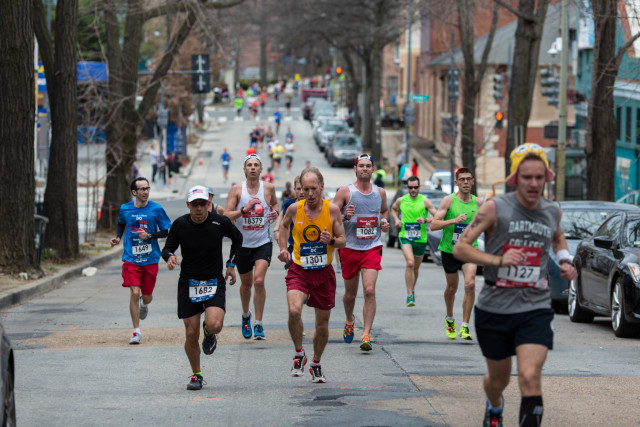
See results at http://www.runrocknroll.com/finisher-zone/search-and-results/?eventid=13
Mother Nature must have been feeling merciful. A radiant sunrise turned to overcast skies, 50-degree temperatures and a slight breeze, providing ideal conditions for over 19,000 racers at the Rock ‘n’ Roll D.C. marathon and half marathon.
Runners at the starting line were happy to avoid a repeat of last year’s cold rain.
“Perfect. This is perfect,” said Alex Smith, who flew in from Milwaukee for the race. He chose Rock n’ Roll because it was the closest big marathon that would motivate him to keep training in Wisconsin’s harsh winter.
Vincent Reddish and Joshua Cowan said they were excited, nervous, and ready to start. Cowan was one of 518 runners at today’s race running on behalf of St. Jude Children’s Research Hospital; the team raised over $200,000 for the charity.
Martha Nelson, though, missed the rain. The defending champion said last year was the smoothest marathon she’s ever run whereas this year proved to be more of a mental challenge.
“Getting the F1 [bib number] puts a lot of pressure on. I knew as much as I told myself you don’t have to win, you’re always going to have that defending champion bullseye on your back.”
Nelson, who lives in D.C., relaxed by helping pace a friend to a sub-3:00 finish and taking advantage of her hometown advantage. “It’s a fun race for me because I get to see a lot of friends along the course,” she said.
Nelson reeled in the eventual runner-up, Lori Nedescu (2:59:55), on the big hill in Fort Dupont Park near mile 21. “I felt if I could pass her going up the hill, that meant that I had more strength. It’s a hard thing to take the lead when you’re that exhausted.”
She struggled in the final miles, but gutted it out to finish in 2:58:02. Katie Moran (3:04:33) finished in third.
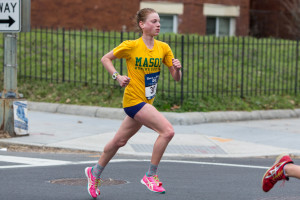
The closest 1-2 finish of the day came during the women’s half marathon. Bethany Sachtleben (1:19:43) and Kerry Allen (1:20:07) raced together for the first half, with Laurel Le Moigne joining for part of the Rock Creek Parkway portion, but Sachtleben pulled away around mile eight and never gave up the lead.
“It was fun to have our little pack for a while,” Sachtleben said. Today’s race helped her prepare for the U.S. half marathon championships in late April.
Hannah Eckstein (1:19:24) finished third in her first half marathon.
Both men’s races were blowouts. Mizael Carrera (1:06:16) went in knowing he could be the top finisher and left no doubt as he led from the gun, two minutes under his PR and over a minute-and-a-half ahead of his nearest competitor.
He slowed from his goal pace of 5-minute miles as he got into the race. “I didn’t look at the course elevation, so I didn’t know there were hills. I kind of backed it off because I didn’t want to hit the wall.”
Carrera is training through this race to prepare for an April marathon in Germany, where he hopes to qualify for Puerto Rico’s Olympic team.
D.C.’s Carlos Jamieson edged out Bethesda’s Andrew Brodeur for second place. At the awards ceremony, Brodeur said “the wheels just came off” in his final ten steps. Jamieson won last year’s race and later qualified for the U.S. Olympic Marathon Trials, but a hot day in Los Angeles forced him to drop out halfway through. He wore his old high school uniform, that of North Rockland, N.Y., which saw its girls distance medley relay team with the New Balance Nationals Indoor title the day before, in a national record time.
Alfredo Arevalo Reyes, who signed up for the marathon this week, ran a lonely 2:30:04 to win by over four minutes. Even with the commanding lead, the two-time Olympian glanced over his shoulder throughout the race to make sure no one would catch up to him. To his surprise, no one ever did.
Reyes, 40, was excited to win a marathon on U.S. soil, even if he didn’t get his qualifying time for the 2016 Olympics. At the finish, he hoisted the flag from his home of Guatemala, one of 47 countries represented by Rock n’ Roll racers this morning.
Steve Chu (2:34:09) finished in second while Dirian Bonilla (2:37:25) finished third.
Dickson Mercer (16:10) and Kendahl Melvin (20:54) each took first place in the 5k. Guler Koca (2:16:38) and Salomon Vazquez (3:34:39) won the marathon’s wheelchair division; Daniel Hagarty (2:12:15) was the top wheelchair finisher for the half marathon; Amanda Strite (33:23) and Erin Kelman (26:45) won the wheelchair 5k.
[Best_Wordpress_Gallery id=”5″ gal_title=”Rock n]
D.C.’s weather also made an impact on the finish area this year. Race organizers added changing tents after soggy runners went home shivering in 2015 and moved the finish line because the original spot was still covered in stubborn snow piles.
Aimee Price of Williamsport, Md., said the mild winter this year made training for the half marathon a little easer. She and Tamara Krumm both loved the course. “It’s always good. You can see all of Washington,” Krumm said.
Brigitte Todd said her half marathon time wasn’t her best because she’s coming back from injury. “I took it easy, I stopped a couple times, I drank champagne and margaritas on the way” courtesy of some roadside fans in the middle of the race.
“I wasn’t taking it very seriously,” she said with a laugh.
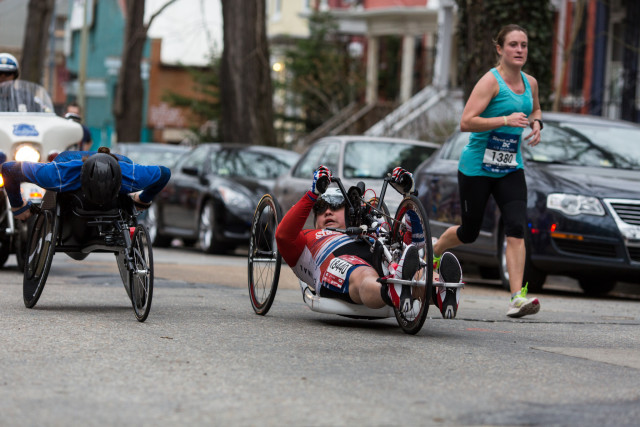
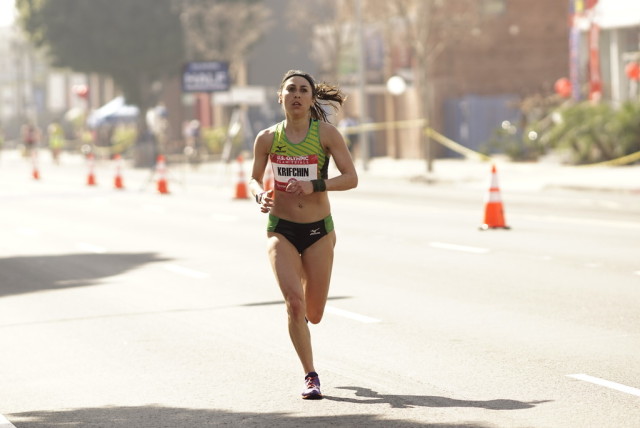
Correction: On subsequent inspection, several other competitors ran personal bests in the race.
Maegan Krifchin might not have made the U.S. Olympic team for the marathon, but she got something out of Saturday’s Olympic Trials in Los Angeles that nearly as rare: a personal record.
[button-red url=”http://www.usatf.org/Events—Calendar/2016/U-S–Olympic-Team-Trials—Marathon/Results.aspx” target=”_self” position=”left”] Results [/button-red]She was one of as few as six finishers in men’s and women’s races, 254 in total, who improved on a previous marathon best.
“Obviously the main goal was to make the team, but I came a little shy of that,” Krifchin said. “Being in the top 10 was a good thing to accomplish.”
More Trials coverage
She was one of four D.C. area women to finish in the top 25. Krifchin and Lindsay Flanagan, who finished 14th, live in Silver Spring and train with Stafford resident Serena Burla, who finished in eighth place. The trio are sponsored by Mizuno. Susanna Sullivan, of Falls Church and Capital Area Runners, finished 20th.
The feat was remarkable because of both the heat and amount of sunlight that baked the course after a late-morning start, taking temperatures to the high 70s, and because the championship setting, with the top three making the Olympic team, made the race tactical.
“They went out pretty conservatively, but they stuck their noses in there. Maegan had the confidence to do that even though it’s just her second marathon,” said Isaya Okwiya, the Mizuno women’s coach. “Time is out the window and you’re just racing people.
“There are a lot of variables in the marathon even in good weather. You don’t know how much your body can handle, so it’s very difficult under these conditions to know where your red line is.”
Krifchin spent most of the race on her own after the lead pack broke during mile 12, but she felt like she made the right move holding back, especially because even then she didn’t feel “safe.”
“I think if I had gone with the lead group, I probably would have fallen off earlier,” she said. “It was really lonely out there, that was even worse than the heat for me, but I feel happy with how I ran.”
The conditions were improved from her win at the Rock ‘n’ Roll Chicago Half Marathon last July, with added high humidity to race temperatures that topped LA’s.
Krifchin, Burla and Flanagan spent a few months prior to the trials training in Albuquerque, which forced the trio to train in layers to help them acclimate to a hot race day.
Burla came into the race with the fifth-fastest seed time, but her training leading up to the race left her worried.
“I think I prayed from the very start to the very end,” she said. “That, and just putting one foot in front of the other was the only way I was going to finish. It hurt every step of the way.”
Despite that difficulty, and with her 2012 trials dropout still haunting her, Burla was determined to race.
“I had to adjust and just try to put myself in a good position and make gradual moves,” she said. “I wasn’t going to be able to make surges so I sought consistency. There wasn’t a whole lot of movement, or other people out there, so I spent a lot of the race thankful for the chance to be out there.”
Burla finished in 2:34:22.
Flanagan did try to cover the lead pack’s move in mile 12, but learned quickly it was a little too much for her.
“I took too big of a chance by surging with the lead pack,” she said. “It hit me really soon, within a mile, and I knew I was in for a rough ending.”
She was able to pick off a pair of runners in the closing miles to rebound a little to finish in 2:39:42.
“It was pretty brutal. It took a lot to finish, and I’m proud that I competed and finished, because it got pretty tough.”
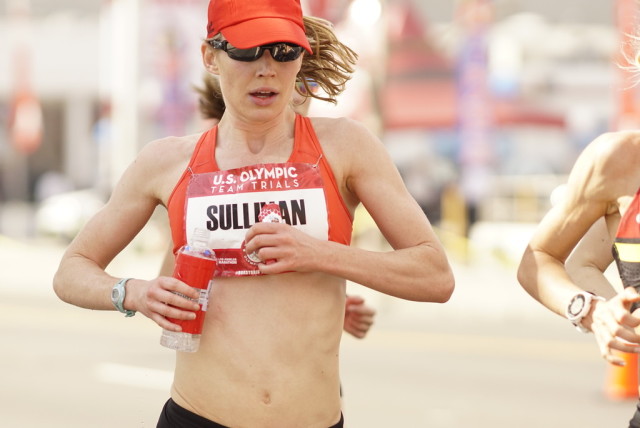
Sullivan finished 20th in her first trials, running 2:41:18.
“It was kind of a bloodbath out there, I just had to keep it in my head that I could keep going,” she said. “I used the cooling stations, took a lot of gels, drank a lot of water, but my quads were just shot. I never thought I wouldn’t finish the race because I ran out of energy, but I might have had trouble just because my legs didn’t work.”
But she held on, which is more than 49 of 198 who started could say. Sullivan was ranked 32nd among full marathon time qualifiers coming into the race.
“In one stretch, I went from 25th to 19th, but it was because people were dropping out,” she said. “I knew I could make it to the finish line, but I wasn’t sure if it would be walking.”
“I knew I wasn’t going to feel the way I did at Grandma’s (her first marathon, in June 2015),” she said, “but with nine miles to go, I felt worse than I did at any point during Grandma’s.”
“Who would have guessed 2:41 would get 20th,” said Sullivan’s coach, George Buckheit. “She’ll be back, she’s only 25. She did everything she could have done, and she did pretty well.”
She joined Buckheit and several teammates in Virginia Beach during Snowzilla to keep her training going during the blizzard.
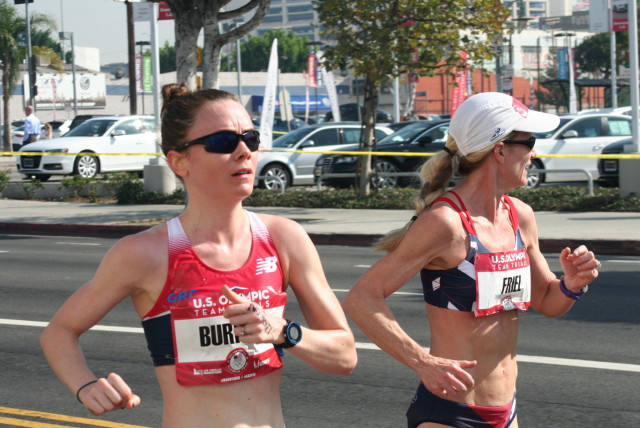
Teal Burrell, on the other hand, was stuck in D.C. as the blizzard approached and fretted about what to do for her last long run. She moved it up a day until Friday, when Beach Drive in Rock Creek Park would not be closed to traffic, and switched the venue to a windy and demoralizing few laps of Hains Point in East Potomac Park. It left her wounded three weeks from the race, but not dead.
The race was the culmination of a dream old enough to be in third grade. Her chiseling and hacking away from a 4:07 debut marathon down to to a 2:42:13 at the California International Marathon to qualify for the trials, along with the openness and vulnerability that were hallmarks of her blog, made her a role model to many.
And even though her race didn’t have the absolutely storybook ending she set out for once she wrote her ticket, she wound up in the top half finishers on a day that could have been a nightmare for her. As much as Krifchin can adapt to the heat, Burrell can struggle in it.
“I wanted to get a PR, that’s what I trained for, but the weather wasn’t cooperating,” she said, following her 2:50:35 finish for 72nd out of 149. “My goal was going to have to be to enjoy the race, and I was at peace with that for about two laps.”
Actually, at mile 10, she was on pace to break her personal record.
“But the next mile I was way off, so I didn’t even look at the clock until I had a mile to go,” she said. “Usually I’m super upset when I don’t get a PR and I kind of act like a brat, but I feel a lot better today. I think I’m more mature about it.”
Toss in the fact that her time was her second-fastest marathon, she has to be happy about that. Aside from the weather, the race was a dream.
“I was so excited to have my name on my bib,” she said. “People I didn’t know were cheering for me and that really drove home how different this race was. Everyone was so supporting, they told me to keep picking people off. By that point, I was just putting one foot in front of another.”
The cooling stations, which included sponges and wet towels soaked in ice water, became something to look forward to.
“The had it set up so you went by it twice on every lap,” she said. “I was putting the towels around my neck like I was in an Ironman.”
She also got a boost from her 20 family members and friends who traveled to watch the race.
Jerry Alexander, coach of the Pacers/Georgetown Running Club New Balance team Burrell joined in 2012, said her 72nd finish, after being seeded 117th among marathoners, was a testament to her arrival on the scene.
“When we look at all of the people Teal beat today, people who have run much faster, on a day that was not at all suited to her strengths, she’s going to be very excited about where she’s come.”
Emily Potter, of Alexandria, a recent addition to the Pacers/GRC New Balance team, finished 102nd in her third Olympic Marathon Trials, running 2:55:10. Though far from her goal, Potter tried to make the most of the race.
“I’d look around when the lead packs would come and hope I’d at least wind up on the tv broadcast,” she said.
Alexander could see from the start Potter wasn’t comfortable.
“She didn’t give up, though,” he said. “By the third and fourth laps, she was actually looking better than a lot of people.”
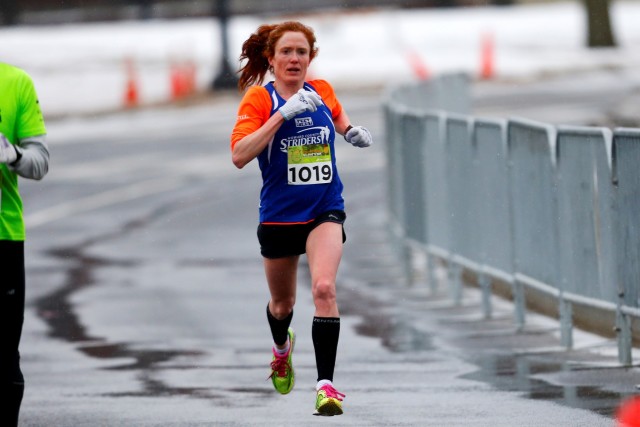
Limbo Relief for one runner
Our soon-to-be-released spring magazine notes that 10 local athletes will compete in the U.S. Olympic Marathon Trials. It also mentions that one runner’s entry was still in limbo.
Julia Roman-Duval, 33, of Columbia, Md., had run a personal best and trials-qualifying 2:40:55 at the California International Marathon — but as we went to press, she was still waiting to hear whether or not she would be allowed to compete.
Good news: Roman-Duval is in.
The backstory is that Roman-Duval, native to France and a permanent United States resident for five years, needed one of two things to happen to compete in the trials. She either had to gain citizenship before the race or the USATF had to be satisfied that her citizenship would be granted before the Olympics in August.
At this point it looks like Roman-Duval will have both scenarios working in her favor, though it was a long, tense ride to get there. She had applied for citizenship in July and, through her own homework, determined that the United States Citizenship and Services’ office in Baltimore would not process her application until March. Too late.
Next she turned to the USATF. But as of last week, no decision had been made, and Roman-Duval said that a USATF staff member had cautioned her not to get her hopes up. It was not likely she would be allowed to compete, she said she was told, unless her naturalization interview was scheduled before the trials.
“Hope started to fade at that point,” she said, “and I started to prepare myself for the idea that I would not be at the trials.”
Imagine training your heart out for a dream race that might not happen. On Saturday morning, Roman-Duval, physically able but mentally exhausted from all of the uncertainty, set out for her last long run still wondering if it was all for naught. That afternoon, though, she went to the mailbox one more time and found her answer. It was none other than a letter from U.S. Rep. Elijah Cummings (D-Md.) containing the good word that his staff had successfully expedited her naturalization interview.
The interview will happen this Friday, eight days before the trials. Thus, on Friday, Roman-Duval expects to both gain her citizenship and, at the very least, could present impending proof of citizenship to USATF. With that, early this week, Roman-Duval heard from USATF’s Jim Estes that she was in.
Roman-Duval has resided in the United States since 2006. She and her husband, who is a U.S. citizen, have three children, and as an astrophysicist, Roman-Duval is part of a team that contributes to the success of the Hubble Space Telescope. A triathlete who did not run in high school or college, she achieved solid marathon results off running just 12 miles a week. Based on that, her Howard County Striders teammates convinced her to gradually increase her mileage and intensity so she could take a shot at the trials standard.
“I still can’t believe it,” she said. “It has been such a long and hard struggle to make this dream come true before the deadline,” from trimming 20 minutes off her marathon personal best to finally gaining eligibility.
“My family” — including her husband, Miguel Roman — “is very excited and proud,” she said. When she told her youngest children, 3 and 4, about the news, they “listened, nodded, and moved on with their activities.” Her oldest, who is six, is anxious knowing she will be away from home for a few days, but has nonetheless been sharing the news at school.
Her Striders teammates are relieved too.
“Julia is a fantastic runner,” said masters runner Mick Slonaker. “She trained very smartly to get her trials qualifying time. We are very happy for her and proud of her.”
In 2000, McLean resident and fellow native of France Philipe Rolly was not as lucky. As a permanent resident, he was forced to sit out of that year’s trials and never ran the standard again.
But Roman-Duval will get her shot, and though she is not sure if another miracle is on the horizon, she is ready, for now, to relax and enjoy the taper. “I am also starting to think about the future,” she said, “and how this milestone will help me take my running to the next level.”
The Baltimore running scene will also be represented by Andy Weaver and former resident Christine Ramsey.
For running fans, the U.S. Olympic Marathon Trials are like a cult classic on a four-year loop. Every time the races are upon us, it feels as if we just saw the last ones yesterday. We again wonder: who will break through to the Olympics, who could surprise us, and who among our local running scene will be there.
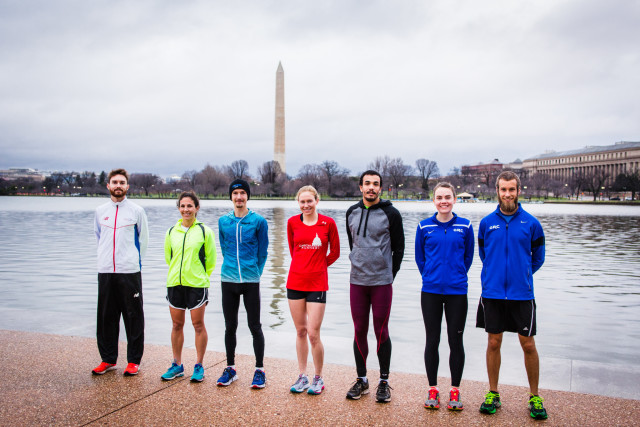
Meanwhile, outside the circle of hardcore running fans, there is some confusion about what the marathon trials even are. We saw this in 2003. Alexandria’s Heather Hanscom won the Marine Corps Marathon, her debut, fast enough to qualify for the trials and was interviewed by Andrea Koppell on CNN. Koppell asked if Hanscom’s goal had been to make the Olympic team; Hanscom explained she had only qualified for the trials; and Koppell ended the segment by wishing Hanscom luck … in the 2004 Olympics.
Follow the race
The race will be broadcast at 1 p.m. eastern on NBC and will stream on NBC Sports Live Extra, Saturday Feb. 13. You can download the app here.
The men’s race will begin at 1:06 and the women will start at 1:22.
RunWashington will be at the race posting updates about local athletes to Facebook and Twitter (@RunWashington) and Instagram (also@RunWashington)
So, what are the U.S. Olympic Marathon Trials, exactly?
The trials — first contested by men in 1968 and by women in 1984 – are both the inspiration and culmination of dreams. There is no qualifying race for the Olympics in which the door is open wider to amateur athletes. They just have to climb a mountain to go through it.
To qualify for the 2016 marathon trials in Los Angeles, men had to run a marathon faster than 2:19 or a half marathon faster than 1:05, while women had to go under either 2:45 or 1:15. (In December, both marathon standards were softened slightly — by a minute for men, two minutes for women — but they are still tougher than they have been historically.)
For D.C. runner Jim Hage, the marathon trials was a force that pushed him to go all in. Before his second trials, in 1992, he quit his job to train full time and went on to finish inside the top 10. His eighth place finish in fact matched his prediction for himself in a prerace trials pool with friends — “but that was based on a best-case scenario,” he says, “and I was ecstatic with the finish.”
For Landover legend Darrell General, the trials fueled consistency. He is among a rare few to run in five trials.
And for Hanscom, a physician assistant in Arlington, the trials was an opportunity to put her best fitness on the line and see where it would take her. Coached by Matt Centrowitz, the 2004 race was only her second marathon, and she knew it would be much dfferent than her first, which she won by more than 20 minutes.
As she steeled herself for the next challenge of going toe to toe with the nation’s best, Hanscom’s mantra became: “to be able to walk away from a race, or any experience, and know that I did my best.” She remembers seeing her family members and friends who traveled to St. Louis to support her. She remembers feeling the whole time like she would “implode” and the way everything hurt, especially her blistering feet. And as she crossed the line, and as her sixth place, 2:31:53 performance — a seven-minute personal best — came into focus, Hanscom could see that “anything was possible” and, almost immediately, started looking towards the future.
The marathon trials, seen from a national perspective, trace the history of modern road racing: boom after boom after boom. And as we head into the 2016 trials, in Los Angeles, and look at this from a local perspective, we can see our own boom: our running scene has never had more representation.
By our count, ten athletes residing in either D.C. or Northern Virginia will be on the starting line Feb. 13. In the Baltimore area, Andy Weaver has qualified, too.
Here are some of the storylines we’re following.
The contenders
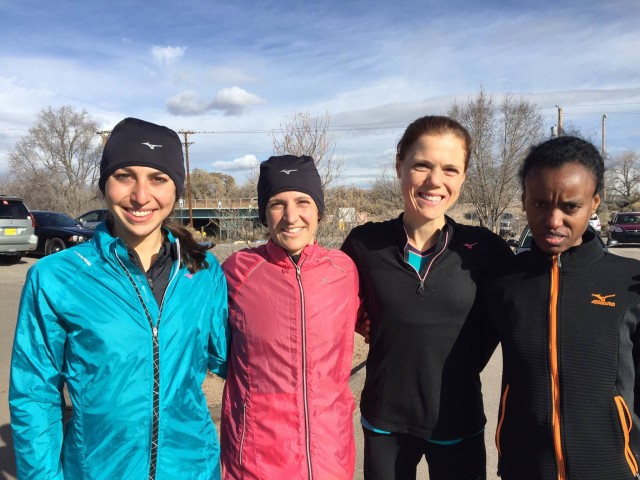
In the women’s race, Shalane Flanagan is the clear favorite. But take note, we have our own Flanagan to cheer for: Lindsay, an Illinois native and recent University of Washington graduate. She moved to Silver Spring last year to join a Mizuno-sponsored training group with Maegan Krifchin and Serena Burla.
Flanagan’s 2:33:12 debut in Houston seeds her at 19th heading into the trials, but her second marathon, though slower, was even more impressive. At last summer’s Pan American Games in Toronto, Flanagan went out with the lead pack and persisted through humid, brutal conditions to earn a bronze medal in 2:36:30. An American woman had not medaled in the event in 20 years.
As of December, when we reached out to their coach, Flanagan and her training partners were out in Albuquerque, New Mexico. In a RunWashington story last fall, though, Flanagan talked about their routine when training in Silver Spring. The trio would meet for workouts at 7 a.m. and in the late afternoon, with Burla commuting in from her home in Stafford.
At the last trials in Houston, Burla, now 33, was in the mix at the front of the pack, but collapsed at 18 miles due to hypoglycemia. Burla, however, had already conquered tougher setbacks. In 2010, for instance, after finishing second at the USA Half Marathon Championships, she scheduled some tests to figure out why her hamstring was hurting. Turns out, the pain had been stemming from a malignant soft-tissue tumor that required a radical surgery. Her surgeon was concerned that Burla would never run again.
Burla not only ran again – she qualified for the marathon trials, and after dropping out, came back in her next marathon to chop her personal best down to 2:28:27. She has since chiseled her personal best down to 2:28:01, giving her the 5th seed heading into Los Angeles. In 2014, she triumphed at the USA Half Marathon Championships. And last year, a month after Flanagan’s result in Toronto, Burla finished 10th in the marathon at the world championships in Beijing.
Krifchin, too, could factor in the race to make an Olympic team. The New York native and Syracuse graduate’s marathon debut of 2:33, run last year at the Hamburg Marathon, seeds her two spots behind Lindsay Flanagan. In October, though, Krifchin, a part-time occupational therapist, also won the Rock ‘n’ Roll Philadelphia Half Marathon in 1:09:50, giving her a faster half marathon than Burla. Even professionals often approach their debut marathon more conservatively to gain experience, and Krifchin’s was described as a controlled effort (she ran even splits). What’s in store, then, for the 27-year-old’s second attempt at the distance in Los Angeles?
The dreamers
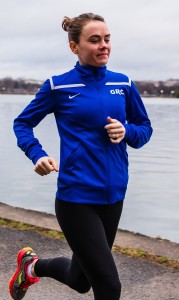
Eight years ago, at the women’s marathon trials in Boston, Teal Burrell and her sister hatched an experiment while they were watching from the sidelines. How long, they wondered, could they keep up with America’s best? When one pack came along, they took off sprinting, and just as quickly fell behind.
Some time before this, Burrell had run a marathon in 4:07 and checked the goal off her list of things to accomplish. For a few years, that was enough. But that day in Boston, Burrell was in the early stages of plotting a comeback. She recalled this memory in 2012 in launching her blog, “Miles to the Trials,” to chronicle her seemingly improbable goal to reach the marathon standard. By then, Burrell had gone from being a recreational runner to sub-3, but she was still a long way from running under 2:45.
Burrell signed off the post, as she typically does, by saying “Dream Big” – and that is exactly what she did, even at times when those dreams seemed unrealistic. Like in 2014 at the California International Marathon, when she lined up with the goal of dipping under the then-trials standards of 2:43. Had Burrell put her recent half marathon best, 1:19:28, into a race predictor calculator, the computation would have read: don’t even think about it. Instead, after running 16 miles at goal pace in practice, she pressed forward, and believed, and crossed the line in 2:42:13.
Now that moon-shot race is here, and Burrell, who is coming off a half marathon PR that still not does compute to sub 2:43, has yet again attached herself to what she describes as another unrealistic goal. Like usual, the pure marathoner is operating on a combination of confidence and fear.
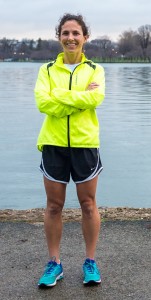
“I’d say I’m more confident in my abilities since CIM, but I certainly still have many, many moments of self doubt. I think that’s the same it’s been in my entire progression as a runner — with every new PR I think I can keep getting faster … but I also have days when my new goals seem crazy, and it’s hard to believe I ever ran 2:42.”
Meanwhile, one of Burrell’s teammates on the Pacers Running//GRC New Balance team, Emily Potter, of Alexandria, has qualified for her third trials, but this was one was perhaps the least probable.
The 36-year-old had the will to train and get in races to advance her preparation. But Potter also had more on her plate – namely, raising two young daughters, Evelyn, 3, and Adelaide, 1. Potter, frankly, was not sure if she could find the time to train like she has in the past, and she hasn’t trained the same way. To make it work, Potter has been bringing Evelyn and Adelaide along for the ride, logging the vast majority of her miles while pushing them in a jogging stroller
In August, with qualifying time running out, Potter headed up to the Edmonton Marathon and covered the course in 2:42:56, just under the standard yet 18 minutes ahead of second place. She set a course record, too.
Since qualifying for the trials, Potter has been trying to make sure she at least gets to run solo for a weekly workout and long run. Otherwise, not much has changed.
“Training wise, I’m just trying to fit in as much running as my kids will tolerate. So it’s less mileage and quality work than I did before previous trials, and practically zero recovery time, but that’s life as a mom.”
The debutants
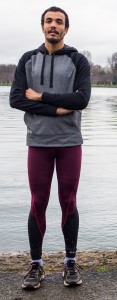
As the Jan. 17 qualifying deadline for the trials approached, runners needing the standard flocked to fast half marathons, including the Philadelphia Rock ‘n’ Roll Marathon on Halloween. For those who succeeded, oftentimes the next question became: “Do I really want to run my first marathon at the trials?” Carlos Jamieson, who qualified in Philadelphia, and Chris Kwiatkowski, who notched his second sub-1:05 half marathon there, decided the timing was right.
In Philadelphia, Jamieson, 28, a physical education teacher in D.C., qualified by running a three-minute personal best, 1:04:27. The American University graduate had been making a gradual shift up to longer distances, starting with a win at the D.C. Rock ‘n’ Roll Half Marathon in March, while he was training for track races. Last spring, he ran 13:50 for 5,000 meters, a personal best.
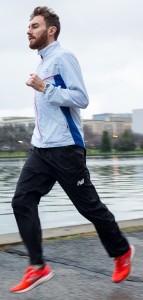
After track season, Jamieson upped his mileage and lengthened his intervals to gain the strength he needed for longer races. But even after qualifying, Jamieson says he had his doubts about whether it was wise to make his marathon debut in such a high stakes, competitive race.
To gain clarity the self-coached Jamieson consulted with his “advisors.” College teammate Dustin Emrani, a half-miler and member of Israel’s Olympic team, told him: if he was going to do it, make it count. Colin Eustis, who has the school record in the indoor 5,000, urged him to take advantage of what could be a once-in-a-lifetime opportunity. So Jamieson again increased his mileage— he’s up as high as 105 miles per week, all in single runs. He says his goal is “to compete to the best of my ability” and meet what he describes as an “ambitious goal.”
Kwiatkowski, an American University assistant coach, competed for the University of Oregon but was limited by a series of injuries. Since settling in Arlington, though, Kwiatkowski has established himself as the top runner in the area, most notably with his fourth place, 48:17 finish at the Army Ten- Miler in 2013. Kwiatkowski says his decision to make the leap up in distance came down to wanting to take advantage of a great opportunity. “I had a small debate about whether to run or not, but I decided pretty quickly to compete. You only get the opportunity every four years, and I felt like it would be a shame not to compete.”
Over the holidays, Kwiatkowski, coached by Matt Centrowitz, returned to his hometown in Bellingham, Wash., maintaining weekly mileage north of 100 miles. “I’ve been feeling good. … I am definitely a little scared of the marathon distance, but I have been approaching it the same as any race: preparing the best I can to get to the starting line healthy and excited to compete,” he says.
The rising star
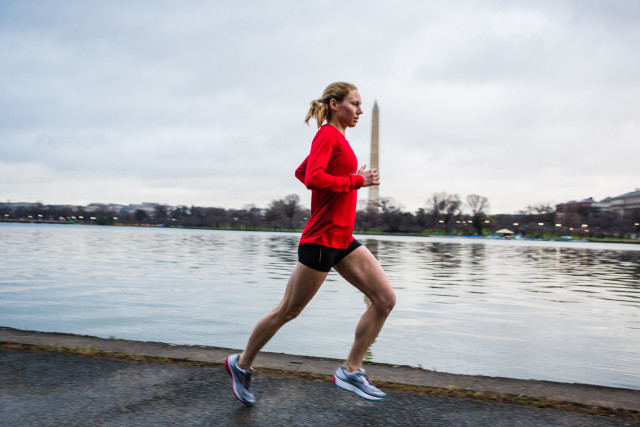
You may recognize me
Some runners with local connections will racing in L.A.
Sara Bard
former Leesburg resident and
Capital Area Runners member
Anna Corrigan
Lake Braddock High School
Ricky Flynn
Damascus High School
Everett Hackett
George Mason University
Mark Leininger
American University
Matt Llano
Broadneck High School
Christine Ramsey
former Baltimore resident who raced here often
Julia Roman-Duval
Columbia resident with an interesting story
Katie Sheedy
former D.C. resident and Capital Area Runners member
Andy Weaver
Baltimore resident who won the 2015 Parks Half Marathon
Hiruni Wijayaratne
Herndon High School
Like Kwiatkowski, Susanna Sullivan was a strong prep runner whose progress in college was slowed by injuries. Sullivan, of Falls Church, ran at George Mason High School and continued at Notre Dame, but has seen her best success on the local roads and at major races around the country. She trains with Capital Area Runners.
Sullivan’s stock shot up in 2014 with a fourth place finish in the national 10 mile championships (none other than the Cherry Blossom Ten Mile Run) and a nation-leading 26:51 at the St. Patrick’s Day 8k. A month out from the trials, Sullivan, not yet in taper mode, lowered her half marathon personal best to 1:12:56.
The ride hasn’t always been smooth. Sullivan, roughly a year ago, did experience some of her first injuries since college. But the 25-year-old school teacher bided her time, completing tough pool workouts and shifting her marathon debut to last year’s Grandma’s Marathon in June.
Her goal was to achieve the trials “A” standard time of sub-2:37, for which athletes get their race expenses covered, and Sullivan says she was surprised by how controlled the pace felt in running 2:35:37. “I was hesitant to make any moves or press too much because I was just focused on finishing. I wanted to get to the finish line with something still in the tank so that I could be excited to really race my next marathon.”
The hard training
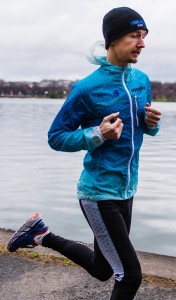
Our trials qualifiers did not get a respite from training during the holiday season. Instead of happy hours and cookies and leisurely mornings, they turned to grueling workouts and two-a-days.
On Christmas morning, Tyler Andrews woke up early and set forth on one of his staple marathon workouts: a continuous effort covering the full marathon distance. He did seven 5k reps at goal marathon pace separated by 1k intervals at a more moderate pace (around 6:00 per mile). The total workout gave the 25-year-old Alexandria resident a full marathon in 2:18, only two minutes slower than his personal best.
There must be a thread on some running message board devoted to the pitfalls of such workouts. But for Andrews, it is clear that workouts like these, and 160-mile training weeks, have led to a transformation: the Tufts graduate, who was never a Division III All-American, is now a 2:16 marathoner poised to go further in the trials.
“It’s all relative, and it has never been about big jumps [in training], just finding what works for me and focusing on increasing that specific stimulus from season to season and year to year,” says Andrews, who is sponsored by Hoka One One and works for Strive Trips, which organizes student service trips. On one hand, Andrews represents a sea change in marathon training, a new generation of marathoners inspired by new, more intense, more hyper-specific training methods espoused by coaches like Renato Canova.
But perhaps it’s simpler than that. Perhaps it goes back to the dream. Consider Kieran O’Connor, who probably doesn’t know who Canova is.
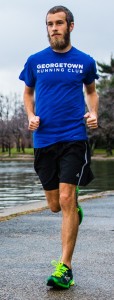
A couple summers ago, he showed up to a Pacers Running//GRC New Balance practice having dabbled in running in high school and having skipped collegiate competition. He had picked running back up after college and, unbelievably, was the 8th American at the brutally hot 2012 Boston Marathon. Except O’Connor had then spent a brutally hot year in Egypt, for graduate school. And there he was, new in town, doing a track workout in basketball shorts and training shoes.
It soon became clear that O’Connor only had one pair of real running shorts. Prior to joining the club, he raced shirtless. At the Leesburg 20k, he had to be shown how to look up his race bib number and then got caught in the bathroom line. His teammates still do call him “the rube.”
But with each race, and each workout, O’Connor crept closer and closer to where he was before Egypt. Then he surpassed that level, and surpassed more levels. After lowering his marathon personal best to 2:20 at Grandma’s in June, O’Connor finished a bit behind Jamieson in Philadelphia to punch his ticket to the trials. One Saturday morning at the track recently, O’Connor set out on a 10-mile tempo with the goal of going under 50 minutes, his teammates flowing in out and out — two laps, three laps, a mile, as far as they could go. O’Connor was rolling.
And it was all part of the plan. “Even when I was a 2:30 marathoner, I was pretty sure that I could get to the trials, which, I don’t now, maybe that’s crazy,” he says. “Now that I’ve reached this level, I have the same certainty that … I can do more and get better.”
With O’Connor, and all of our qualifiers, at the trials, the bar will be set even higher. And when the gun goes off, the dream chasing will continue.
Limbo Relief for one runner
Our soon-to-be-released spring magazine notes that 10 local athletes will compete in the U.S. Olympic Marathon Trials. It also mentions that one runner’s entry was still in limbo.
Julia Roman-Duval, 33, of Columbia, Md., had run a personal best and trials-qualifying 2:40:55 at the California International Marathon — but as we went to press, she was still waiting to hear whether or not she would be allowed to compete.
Good news: Roman-Duval is in.
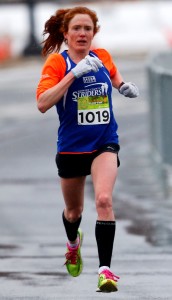
The backstory is that Roman-Duval, native to France and a permanent United States resident for five years, needed one of two things to happen to compete in the trials. She either had to gain citizenship before the race or the USATF had to be satisfied that her citizenship would be granted before the Olympics in August.
At this point it looks like Roman-Duval will have both scenarios working in her favor, though it was a long, tense ride to get there. She had applied for citizenship in July and, through her own homework, determined that the United States Citizenship and Services’ office in Baltimore would not process her application until March. Too late.
Next she turned to the USATF. But as of last week, no decision had been made, and Roman-Duval said that a USATF staff member had cautioned her not to get her hopes up. It was not likely she would be allowed to compete, she said she was told, unless her naturalization interview was scheduled before the trials.
“Hope started to fade at that point,” she said, “and I started to prepare myself for the idea that I would not be at the trials.”
Imagine training your heart out for a dream race that might not happen. On Saturday morning, Roman-Duval, physically able but mentally exhausted from all of the uncertainty, set out for her last long run still wondering if it was all for naught. That afternoon, though, she went to the mailbox one more time and found her answer. It was none other than a letter from U.S. Rep. Elijah Cummings (D-Md.) containing the good word that his staff had successfully expedited her naturalization interview.
The interview will happen this Friday, eight days before the trials. Thus, on Friday, Roman-Duval expects to both gain her citizenship and, at the very least, could present impending proof of citizenship to USATF. With that, early this week, Roman-Duval heard from USATF’s Jim Estes that she was in.
Roman-Duval has resided in the United States since 2006. She and her husband, who is a U.S. citizen, have three children, and as an astrophysicist, Roman-Duval is part of a team that contributes to the success of the Hubble Space Telescope. A triathlete who did not run in high school or college, she achieved solid marathon results off running just 12 miles a week. Based on that, her Howard County Striders teammates convinced her to gradually increase her mileage and intensity so she could take a shot at the trials standard.
“I still can’t believe it,” she said. “It has been such a long and hard struggle to make this dream come true before the deadline,” from trimming 20 minutes off her marathon personal best to finally gaining eligibility.
“My family” — including her husband, Miguel Roman — “is very excited and proud,” she said. When she told her youngest children, 3 and 4, about the news, they “listened, nodded, and moved on with their activities.” Her oldest, who is six, is anxious knowing she will be away from home for a few days, but has nonetheless been sharing the news at school.
Her Striders teammates are relieved too.
“Julia is a fantastic runner,” said masters runner Mick Slonaker. “She trained very smartly to get her trials qualifying time. We are very happy for her and proud of her.”
In 2000, McLean resident and fellow native of France Philipe Rolly was not as lucky. As a permanent resident, he was forced to sit out of that year’s trials and never ran the standard again.
But Roman-Duval will get her shot, and though she is not sure if another miracle is on the horizon, she is ready, for now, to relax and enjoy the taper. “I am also starting to think about the future,” she said, “and how this milestone will help me take my running to the next level.”
This story appears in the Spring 2016 issue of RunWashington.
In the months leading up to 2015’s Fall marathons, RunWashington will follow several local runners as they prepare for their races. We’ll chart their progress as they train their legs, lungs and minds for the challenges they’ll race on race day. Each week, we’ll catch up with our runners and see how they’re doing. Matt Deters is training for the Philadelphia Marathon. Read more about him here and here.
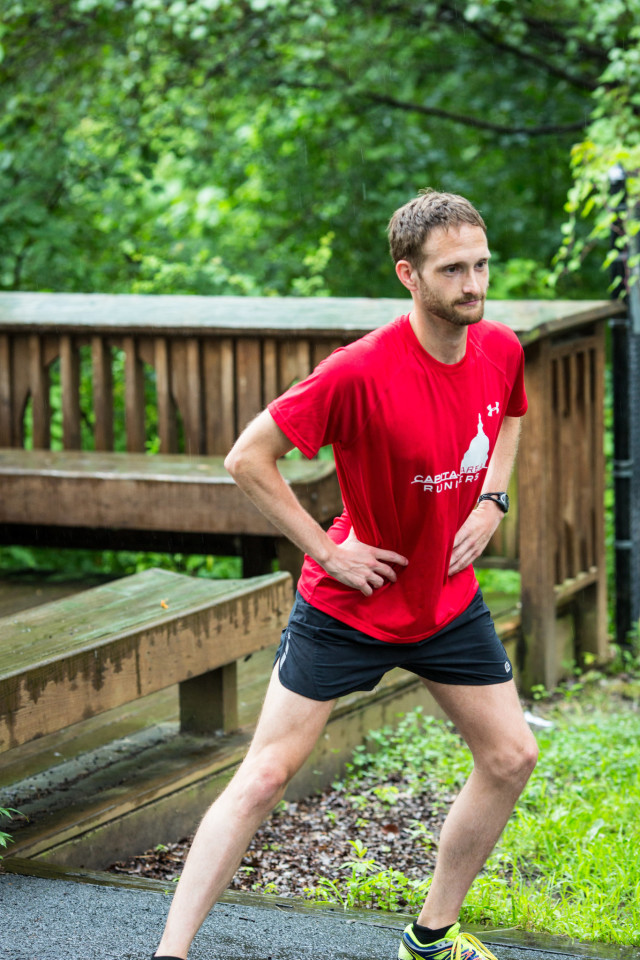
After a summer colored by training ups and downs, including nagging pains, a lingering bug, and the ongoing battle with Washington weather, Matt Deters, who performs better at cooler temps and lower dew points, is really starting to feel like he’s found his footing.
Deters still doesn’t like the heat, but after a long summer, he’s functioning better in it. He’s upping his game when it comes to hydration and continuing his commitment to injury prevention. Now that he’s into the meat of marathon training, all the little things are coming together.
Much of Deters’ daily and weekly routines center around running, but he likes it that way. “It’s very rigid, each day is similar,” he said.” That’s actually important to marathon training. Certain people like that. I find that really centers my life.
When he thinks about it, running takes up about three hours out of his day, or 20-30 hours per week. His training involves miles, miles, and more miles. Last year, running 100 miles in a week was a goal for Deters, now he is doing that as part of his regular training regimen.
The training cycle Deters and his teammates are following is the same one he was doing going into last year’s Glass City Marathon – a great race that almost was. In fact, after putting up an exceptional half marathon performance of 1:09:45 at Shamrock, Deters had two races cut short – Cherry Blossom, cut short after a motorcycle crash, and Glass City, which was cut off for Deters by poor course management.
Deters is hoping to set a ten mile PR at the Army Ten-Miler and is hoping to match his performance at last year’s Shamrock Half in the Navy-Air Force Half Marathon. He has started looking at the qualification times for the U.S. Half Marathon Championships, which, at 1:08, is a jump, but not impossible by any means.
Deters’ training plan was devised by Capital Area Runners coach George Buckheit, whose coaching philosophy, honed over 35 years of coaching marathoners, involves doing many hard long run workouts reaching marathon pace. To counterbalance, the plan also involves a lot of running slow in between hard workouts. In the two week training cycle Deters and his teammates follow, they get five hard workouts in. These include the long progression runs reaching marathon pace as well as tempo and track runs. But the rest of the runs, the miles Deters puts in largely on his commute to work, are supposed to be done easy. To Deters this means a per-mile pace of between 7:00 and 8:00.
His coach explains it this way – “a lot of marathoners think they have to be out there bashing it every day, but with five days hitting it hard, the rest of the time is easy recovery stuff,” Buckheit said. Deters takes this to heart. “A lot of guys who are very competitive ignore that. He buys in.”
Buckheit’s training regimen involves running long runs with significant portions at marathon pace. Progression runs serve multiple purposes – runners have to hold themselves back at the beginning, a challenge to any level and pace of runner, and a crucial skill for maximum velocity racers like Deters and his cohort.
Progression runs also teach runners what it feels like to be at high miles on tired legs at marathon pace. Reaching peak marathon pace at mile 14 of a 21 mile run is a good way to get a feel of what’s coming on race day. Deters has the advantage of having done a very similar training cycle before, and he can feel a slight edge this time around. “My last run I averaged 5:38 for the last seven miles. The same effort last spring was in the 5:40s.”
In addition to closely following the training model of his coach, Deters works on his form consistently. He has gleaned some useful knowledge from the concepts of chi running. “By keeping my pelvis rotated, my back aligned correctly, and my center of gravity where it needs to be, I feel like I can really enjoy my running.” In addition to that, he strengthens his neuromuscular system by working high knees, butt kicks, and other drills to hone his form.
The unexciting things seem to be paying off well for Deters. Running slow on his easy days. Turning in early on weeknights and getting eight hours of sleep. Eating his vegetables. Hydrating. Foam rolling. He’s reached the point in training where he’s “tired, eating all the time, running out of time to do things, but you still feel good,” Deters said.
His performance at the Navy-Air Force Half will be interesting to keep an eye on. “I think he’s very ready. If we get good weather he could be somewhere around 1:08ish,” Buckheit said.
In terms of Philly, Deters says his “B” goal is to break 2:30. Since he doesn’t know what that pace feels like after mile 21, he thinks he can do it but hasn’t had the chance to yet. “Deep down I feel like I could do 2:26. But, I could also break my ankle or get hit by a truck. You just gotta roll with the punches,” Deters said, leaving the door open, as his recent racing history has taught him, for any eventuality.
Buckheit hesitates to make a firm time prediction for Deters due to the unpredictability of the marathon, but think Deters performance will be “at a bare minimum, under 2:30, if everything aligns – 2:25,” Buckheit said.
When asked if the Glass City fiasco is likely to impact Deters’ performance, his coach echoed what teammates have said, “he took it better than I would’ve,” and went on to say that its only adding to his drive, “he’s right back where he was, training wise. It didn’t piss him off, it made him hungrier,” Buckheit said.
With a half marathon and a ten miler coming up before his marathon performance just like last spring, Deters will have ample opportunity to gage his progress from last season, and then he’s got a typically cold, big city race with big city course marshals and markings to get him to the finish line.
Buckheit thinks Deters will be good to go as long as he makes it to the start. “He’s a tough guy,” he said. “I hope everything comes together for him and we get him to Philly in one piece.”
In the months leading up to 2015’s Fall marathons, RunWashington will follow several local runners as they prepare for their races. We’ll chart their progress as they train their legs, lungs and minds for the challenges they’ll race on race day. Each week, we’ll catch up with our runners and see how they’re doing. Meghan Ridgley of Reston, Va., planned to run the Philadelphia Marathon, but has been forced to take the season off. Read the first article about Meghan Ridgley here and the second here.
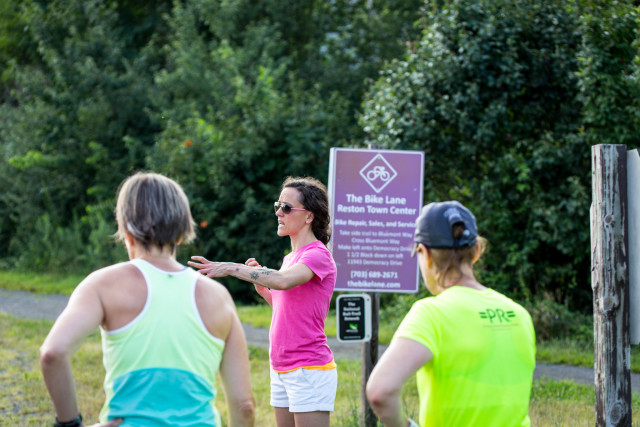
Meghan Ridgley has a lot more time on her hands now that she’s out with a stress fracture and a torn labrum. Still immersed in running through her work at the Potomac River Runners store and as a coach, she insists that she’s ok being around people who are still able to get out and go running. It was actually harder when her ankle was injured because she technically could still run.
“It’s a little hard, but it’s easier to watch people run this time because if I try to run my leg will stop and I will literally fall on my face, so the decision is kind of made for me,” Ridgley said. Instead of wishing she could run, she gets a little secondhand joy from those who can. “I just try to live vicariously through my customers and the people I train. A lot of people are doing the Army Ten-Miler and Marine Corps, I’ll absolutely be cheering them on and that’s gonna be the best,” she said.
Ridgley’s insisting on keeping her outlook positive by focusing on the side benefits of her setback. For the runners she coaches “it’s an opportunity to show people that injuries happen, and that you have to let them heal. Especially for a new runner, they get that injury and they think their life is over,” Ridgely said, joking that the people she coaches will say to themselves: “I don’t want to end up like Meghan so I’ll definitely take some time off.”
Long-time friend and fellow coach Jodi Rakoff has a firsthand insight into how Ridgely is dealing with being sidelined, because both happen to be convalescing from injuries. They support each other by catching up on the couch instead of running together. Ridgely has been there for her and is “definitely taking it in stride even though not exercising is really, really hard,” Rakoff said. She sees her friend Ridgely channel the energy she isn’t using for training to support the runners she coaches and use her injury as a teaching tool.
While Ridgely definitely has let close friends in when she’s feeling the loss of something that she loves and that has always been a central aspect of her life, she’s relieved that overall, “people have commented at how upbeat and enthusiastic I am.”
Ridgely hasn’t gone this long without running since she started running. Even when she was pregnant, even when she took time off from racing, even when she injured her foot. “This is the least amount of physical activity I’ve had. It’s difficult to deal with. I didn’t realize how much of my day involved movement. Fortunately I have a physical job,” Ridgely said. But gone are the daily routines of quick core sets, triceps dips, foam rolls, and pushups in between tasks, tricks the busy mom has honed to keep herself at peak fitness while still doing everything else.
In the place of the time she spent training, she’s sleeping in, and getting to spend more time with daughter Miranda who’s starting third grade this year. She’s cooking more, and has time to do things like drop a plate of cookies off for a friend who’s had surgery.
The extra time with her daughter is definitely the central focus of her decision to look on the bright side. With back to school and a birthday party to prepare for, they’ve been busy together. Miranda reminds Ridgely to wear her brace whenever she has to leave the house and asks about the pain.
As far as recovery and racing goes, Ridgely is playing the waiting game. She’s due soon for her six week check-in with the surgeon, where an assessment of the torn labrum and stress fracture will decide what her running future holds. “Because the stress fracture doesn’t feel remotely healed, in my non-medical opinion, I feel like I’m not going to run this year,” Ridgely said. If the labrum requires surgical repair, she’ll have at least 12 weeks of convalescence.
“I’m anxious for the next step, I’m in the holding patter now,” said Ridgely.
Ridgely had already seen a step back from competitive level racing in her future due to an ankle injury she had orthoscopic surgery on and which will require another operation sometime in the next few years. She is ready to accept that this injury may force her to stop running at the level she’s been at, but isn’t yet taking it as a done deal.
“It’s a different mindset. I’m in the phase of I may need to reevaluate – I want to just be able to run, if that means I don’t get to run super-fast or super-far again, that’s fine – as a result of this, I’m going to be less disappointed,” Ridgely said. “But,” she added, “it’s extra rest for my ankle, that could be what I needed as well.”
Rakoff agrees that the rest is good for Ridgley’s ankle, “it looks like an ankle now. Before we called it the ‘schmankle,’ it was really inflamed,” Rakoff said.
Hoping that your current injury is good for your previous one is the epitome of looking on the bright side. Ridgely is taking the determination she’s used in her training to cultivate her attitude of looking for the good in a situation she didn’t choose. She doesn’t seem to be forcing it at all, rather she gives the impression that whatever comes her way, she’s going to do it the best she can. Even being injured.
Once she’s healed up, she’s planning on a fall marathon in 2016. She figures she’ll take it easy over the winter and then try out some summer races to see where she stands. Without hesitation, when asked about Ridgely’s prospects, her friend and training partner replies “I think she’s gonna crush it 2016. I think she’ll use this to fuel the flame for next year,” Rakoff said.


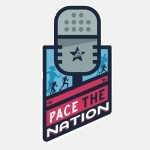 Hear Dickson Mercer talk about our local qualifiers on Pace the Nation
Hear Dickson Mercer talk about our local qualifiers on Pace the Nation